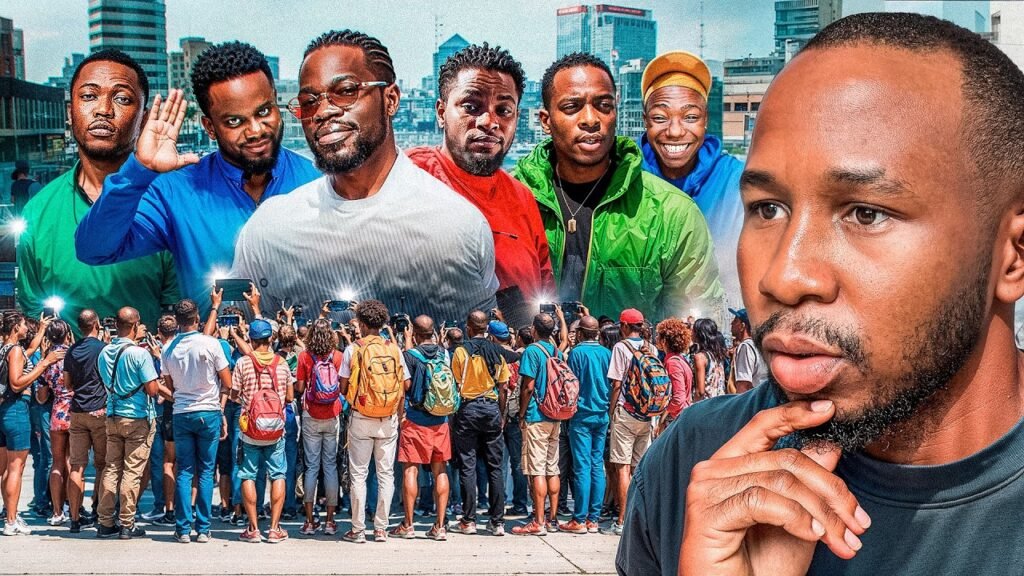
They make you laugh in 60 seconds. But what if I told you that behind those skits, behind the absurd characters, slapstick jokes, and Instagram reels, lies one of the most lucrative industries in modern Africa?
Welcome to the business of skit making, a world where young Nigerians are turning comedy into cash, followers into fortunes, and smartphones into media empires.
From Bedroom Videos to Billion-Naira Fortunes
I’ve always been curious: How are these skit makers buying cars, building houses, and pulling in six to seven figures monthly?
So, I decided to find out.
What I uncovered is a new kind of content-driven entrepreneurship, one where Mark Angel, Shank Comics, Brother Shaggi, Sirbalo, Brain Jotter, and others have turned 60-second videos into streams of wealth that rival some corporate CEOs.
Mark Angel: From Street Hustler to Africa’s Comedy Mogul
At his quiet but expansive home, Mark Angel, one of Africa’s most followed comedians, told me how it all started. No studios, no strategy. Just a young man handing strangers his video clips on the road, asking if they’d like to laugh.
“My first brand deal was ₦300,000 in 2016. That was my lightbulb moment,” he says.
Since then, Mark has scaled beyond viral videos. With 22 million followers on Facebook and over 9 million on YouTube, he has reportedly earned up to $350,000 in a month, although he cheekily refuses to confirm the figure.
Yet, even with over a dozen luxury cars in his garage, he admits:
“Content creation changed my life. But people don’t believe it… until they hear how much YouTube and Facebook really pay.”
Shank Comics: From DMs to a Global Spotlight
When I visited Shank, his follower count across platforms surpassed 11 million — including recent milestones on Twitch and TikTok. But what struck me was his international ambition.
“I spammed KSI, I spammed Kai Cenat,” he told me. “One day Kai replied… and the collab changed everything.”
That single crossover placed Nigerian skit makers on the global map. Shank now earns $20,000–$30,000/month, mostly from Instagram brand deals. But even he admits:
“I’m poor compared to Mr Funny and the rest. Those guys are making real money, bro.”
Brother Shaggi: The Brand Behind the Costume
With 12 million Instagram followers, 9.9 million on Facebook, and a signature look, red cap and camo shorts, Brother Shaggi is a walking, talking brand. The costume isn’t just for laughs. It’s business.
“People know the costume. It’s become the brand,” he told me.
From stage acting at UNILAG to YouTube superstardom, Shaggi credits his success to consistency and understanding the skit formula.
On his earnings? Let’s just say he refused to state a number but couldn’t hide his smile when the guesses started climbing past $80,000/month.
Sirbalo: Eight Channels, 2.1 Billion Views, and a G-Wagon
If you think this is all internet fluff, Sirbalo will change your mind.
“I didn’t expect to get rich from skits,” he says, showing me his eight monetized YouTube channels, his 17 million Facebook followers, and a G-Wagon worth ₦300 million.
His biggest hit? A Facebook video from 2018, a hilarious skit involving a jealous boyfriend at a pool, that earned 2.1 billion views before it was flagged.
Even with Facebook’s monetization issues in Nigeria, Sirbalo worked around the system by partnering with U.S.-based admins who take a cut. Still, the money is staggering.
“Trust me, there’s money on Facebook. Big money.”
Brain Jotter: “When I Think It’s Funny, It’s a Hit”
Some creators second-guess their ideas. Brain Jotter doesn’t.
“If I find it funny, it’s a hit. Every time.”
He earns the most from YouTube, which he calls the most “creator-friendly” platform. Unlike brand deals on Instagram, YouTube’s ad system lets him set income goals and push content accordingly.
“Instagram is when they need you, they call you. But YouTube? I can say, ‘This month, I want to make ₦XX,’ and make it happen.”
Still, like many others, he dodges the income question, citing security and tax implications.
How Exactly Do Skit Makers Make Their Money?
The creators revealed seven major income streams, but these are the big three:
- Ad Revenue from Platforms
Facebook, YouTube, and sometimes TikTok share ad revenue based on views and video length. 1 million views can equal ₦1 million, sometimes more. - Brand Collaborations
This is where the big bucks come in. Endorsements and sponsored posts can bring ₦2M–₦40M per campaign. Some creators blend the ad so well into the skit, you wouldn’t know it’s a paid partnership. - Audience-Powered Business Ventures
With millions of loyal fans, many creators invest in real estate, sell products, or start businesses, and then use their own audience to market it.
“Content is a step,” says Sirbalo. “To music, acting, business, even politics. We start with content, but we build empires.”
What’s Even More Mind-Blowing? They Use Smartphones
When I visited Sabinus’ set in Port Harcourt, I expected to see full production rigs.
Instead, I saw phones.
“They shoot. They edit. All on smartphones,” I said in awe.
No fancy camera. No large crew. Just creativity and a device in your pocket.
The Creator Economy Is Booming. Are You Paying Attention?
In 2024, the global creator economy was valued at over $250 billion. And African skit makers are claiming their share.
Their tools?
A smartphone, internet access, and consistent content.
Their goal?
Make you laugh, and make millions doing it.
And now, with online academies and creator schools popping up, the next generation is learning how to turn followers into finances.
So the next time you watch a skit and burst out laughing, just know this:
While you’re laughing at their jokes, they’re laughing all the way to the bank.
Watch the full documentary here.
